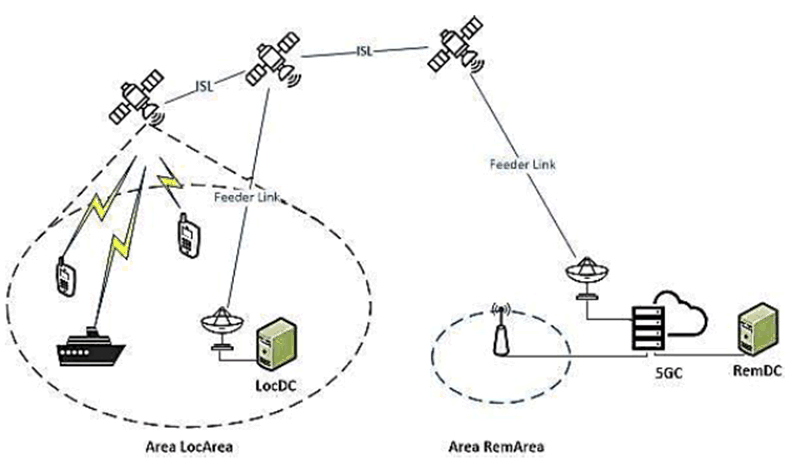Content for TR 22.865 Word version: 19.2.0
5.5 Use case on LAN using Satellite Access
5.5.1 Description
5.5.2 Pre-conditions
5.5.3 Service Flows
5.5.4 Post-conditions
5.5.5 Existing features partly or fully covering use case functionality
5.5.6 Potential New Requirements needed to support the use case
...
...
5.5 Use case on LAN using Satellite Access p. 17
5.5.1 Description p. 17
Satellite access networks are designed to ensure ubiquitous coverage and availability to any users with communication need. Beyond wide coverage capabilities, satellite connectivity can add flexibility to the network topology by providing an alternative route through satellite when terrestrial link is unavailable. The integration of satellite system, to compensate for the limitation of terrestrial network will benefit more users with interim but necessary service need.
When scientist-explorers move to the "blink spots" of terrestrial access network networks (e.g. deserts, oceans, polar regions, etc.), they need to keep collecting scientific data during the regional expedition and store it in local Scientific Research Station for analytic, retrieval, and synchronization with remote Scientific Data Center. In such condition, a provisional local area network (LAN) using satellite access could be an option to provide a temporary reliable communication service.
Scientific Expedition Team with tens of explorers and vehicles arrives at Antarctica to start scientific expedition activities in area LocArea for a month as Figure 5.5.1-1 depicts.

In Figure 5.5.1-1, the local Scientific Research Stationequipped with a data center LocDC will support the data analytics and research in LocArea. The remote Scientific Data Center RemDC located in area RemArea served by Terrestrial Operator TerrA, can support the data analytics, as well as retrieve all the data and research results from LocDC in a fixed time every day.
5.5.2 Pre-conditions p. 18
All UEs of the Team capable of satellite access are the subscribers of TerrA in RemArea.
LocArea has no terrestrial network but covered by satellite-enabled NR-RAN (e.g. LEO) of Satellite Operator SatA.
SatA has an agreement with TerrA to provide 5G network services with the flexible network configuration of satellite and terrestrial elements in LocArea.
RemDC is connected through 5G core network of TerrA.
It's assumed that UEs can always find serving satellites from the constellation. The serving satellite change is omitted from the flow.
5.5.3 Service Flows p. 18
Once the explorers settle down in Scientific Research Station, LocDC is provisioned and authorized to connect to 5G core network of TerrA through satellite or ground gateway regarding the management policy agreed by SatA and TerrA.
All UEs of the Team are enabled the corresponding services in LocArea regarding the device setting and subscription information.
During the activities in LocArea, all UE register to TerrA 5G network through SatA's satellite access network to upload data to LocDC with the optimal route in time.
LocDC can sync up data to RemDC through 5G network configured by SatA and TerrA with the optimal route in each fixed time slot.
When leave LocArea, there are available terrestrial access network of TerrA or other operators in service agreement with TerrA (e.g. roaming, shared network), UEs will be steered to upload data via satellite access to LocDC or terrestrial access network to RemDC regarding the policy.
When LocDC is disconnected from 5G network regarding the original provisioning information, all UE will upload data to RemDC.
5.5.4 Post-conditions p. 18
Local satellite access network of SatA will be routed to LocDC for data exchange when LocDC is in service.
All the data is successfully transferred between UEs and LocDC, UE and RemDC, LocDC and RemDC.
5.5.5 Existing features partly or fully covering use case functionality p. 19
Regarding TS 22.261, satellite access and satellite connectivity are supported in Rel-18, as
The 5G system shall be able to provide services using satellite access.
UEs supporting satellite access shall support optimized network selection and reselection to PLMNs with satellite access, based on home operator policy.
The 5G system with satellite access shall support the use of satellite links between the radio access network and core network, by enhancing the 3GPP system to handle the latencies introduced by satellite backhaul.
The 5G network can also support multiple wireless backhaul connections (e.g. satellites and/or terrestrial), and efficiently route and/or bundle traffic among them.
As clause 6.5 of TS 22.261 illustrates, the requirement of efficient user plane for 5G system with satellite access will be:
- A 5G system with satellite access shall be able to select the communication link providing the UE with the connectivity that most closely fulfils the agreed QoS.
5.5.6 Potential New Requirements needed to support the use case p. 19
[PR 5.5.6-001]
Subject to regulatory requirements and operator's policies, the 5G system with satellite access shall be able to support an efficient communication path and resource utilization for a UE using only satellites access, e.g. to minimize the latencies introduced by satellite links involved.
[PR 5.5.6-002]
Subject to regulatory requirements and operator policy, the 5G system with satellite access shall be able to support service continuity when the UE communication path moves between satellite access network and terrestrial access network.